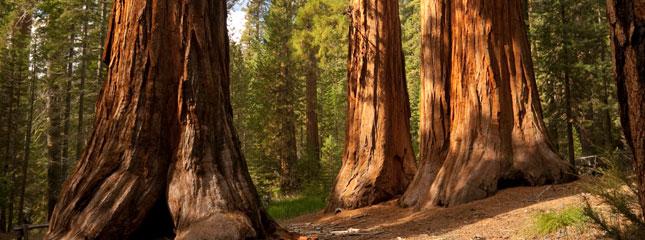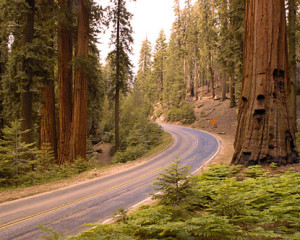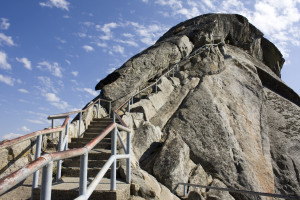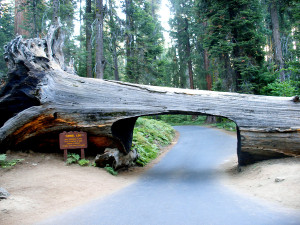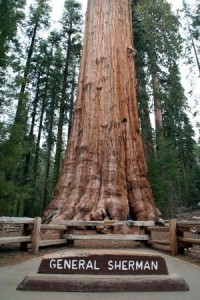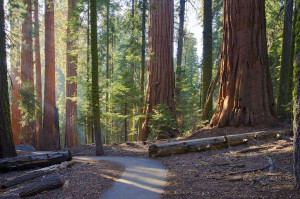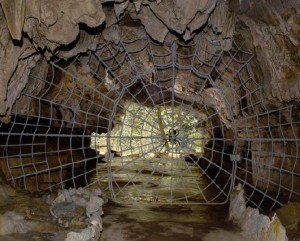Our family has visited Sequoia National Park several times over the past years and we have enjoyed it every time. The majestic giant sequoia trees that grow within the park boundaries are truly a wondrous sight to see! My husband and son have also taken the Crystal Cave wild tour three times with a group of different friends each year and they truly enjoyed the experience of spelunking and being able to explore areas of the cave that the general public are never shown. (please see the end of the post for more information about the wild cave tour)
Located in central California, Sequoia National Park was established as a national park in 1890. The park covers over 400,000 acres in the southern Sierra Nevada mountain range including the highest point in the contiguous United States, Mount Whitney which has an elevation of 14,505 feet. The Sierra Nevada mountain range was formed over 10 million years ago in a series of earth shifts and later over long periods of extreme cold weather glaciers developed and would move slowly over the granite rock to create deep valleys and ragged peaks. These glacial forces also formed nearby Yosemite National Park.
This area in the Sierra Nevada mountains was originally home to the Monochee Native Americans who lived in the foothills but during the summer months they would travel into the high country and go through the mountain passes to trade with the other Native American tribes in the East. Throughout the park, the ancient Native Americans have left behind pictographs and at the Hospital Rock area there are bowl-shaped indentations carved into the rocks that they would use as mortars to grind acorns which were a main food supply for the Monochee.
When the European settlers arrived in this area, a homesteader named Hale Tharp built a home in a fallen giant sequoia that he hollowed out and it can still be seen today on the Crescent Meadow trail. Tharp became friends with John Muir, the naturalist and first president of the newly formed Sierra Club and together they saw the beauty in the giant sequoia trees and tried to preserve this region of California. By the 1880s, the logging companies started cutting down the large sequoia trees but this proved to be an unsuccessful business venture when the lumber was determined to be unsuitable for building material.
Then in 1890, Sequoia National Park was established and the giant sequoias fell under protection and all logging ceased within the boundaries of the newly formed park. Over the years additional areas were added to the park as it increased in size. The most recent expansion was back in 1978, when the Sierra Club succeeded in preventing the Walt Disney Company from purchasing property to create a ski resort. This area in the southern portion of the park known as Mineral King and it is a popular place and starting point for back-country hikers.
Most visitors enter Sequoia National Park by the southern entrance near the town of Three Rivers. (Travel Note: Before proceeding into the park, stop and fill your vehicle with gas as there is very limited availability within the park) Here in the foothills of the Sierra Nevada mountain range the scenery is mostly oak trees and yucca plants and as the road climbs through steep river valleys the scenery transitions into conifer forests of pine and fir trees. Once visitors reach the higher elevation between 5,500 and 9,000 feet the giant sequoia trees start to appear and they are some of the largest living trees in the world, such as the General Sherman tree.
After entering the park boundaries, the road becomes the General’s Highway. (Of course as written in previous posts, our family always stops to take a photo of the National Park sign and these photos are framed and placed on our travel wall in our home) The General’s Highway continues to climb higher and the curving mountain road can be a very challenging driving experience so take caution and observe the speed limits. The first group of sequoias trees visitors will see once they are inside the park are the “Four Guardians”. (Travel Note: We advise visitors to stop safely and pull completely off the road to see these massive trees up close; it is a humbling experience to stand among some of the largest trees on our planet!) For more information about Sequoia National Park, please see their website at www.nps.gov/seki.htm
Interesting sites to see in Sequoia National Park
Moro Rock / Crescent Meadow Road
Located in the southern portion of the park just off the General’s Highway is one of the most popular areas of the park and during the summer months it can be very congested so to avoid the crowds we advise going in the early morning hours. The road is very narrow with limited clearance and it is not recommended for RVs or trailers.
- Moro Rock – This large granite dome is located at an altitude above 7,000 feet and the 400 steep climb to the top can be very strenuous. Once at the top, the views of the Great Western Divide on one side and the Central Valley of California in the distance on the other side are truly breathtaking! (Travel Note: The climb to the top is very difficult and is not recommended for visitors with health issues or fear of heights due to the steep drop-offs )
- Tunnel Log and Auto Log – The Tunnel Log is a fallen sequoia tree that crosses the road with a section cut out for cars to drive through that measures 17 feet wide and 8 feet high, for vehicles that do not meet these restrictions there is a bypass road. (Travel Note: The Tunnel Log is a fun photo opportunity but please use caution when you exit the vehicle to take pictures and be courteous to other park visitors that are sharing the road with you) Located nearby is the Auto Log which is another fallen sequoia that once allowed visitors the unique opportunity to drive their vehicles onto the tree. The tree is still there but it is now closed because the increased decay of the tree has caused unstable conditions to hold the weight of vehicles safely.
- Crescent Meadow – This High Sierra meadow is a beautiful sight to see at any time of the year, but in the summer it is especially lovely and filled with wildflowers. The Crescent Meadow trail is an easy 1.6 mile family-friendly hike, which takes visitors past Tharp’s Log and the Chimney Tree. The Tharp’s Log was the home of Hale Tharp who lived inside this hollowed out fallen sequoia tree, be sure to take a look inside. Located nearby is the Chimney Tree which is a burnt out sequoia tree, visitors can step into the tree for an unusual look inside a giant sequoia and it also makes a great photo opportunity. (Travel Note: When we visited several years ago we encountered a bear in this area of the park, so please be aware of the danger and use extreme caution)
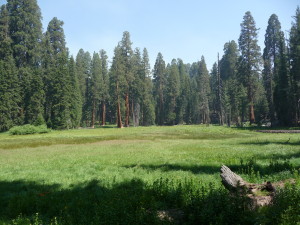
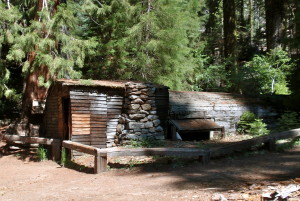
The Giant Forest
Located near the center of the park is the Giant Forest area just off the General’s Highway. The Giant Forest area and the Congress Trail is a wonderful opportunity for visitors to walk among several groves of giant sequoia trees. It is truly an amazing experience to stand at the base and look up to realize just the massive size of these sequoia trees. (Travel Note: The parking lot for the General Sherman tree and the Congress Trail can get very congested, especially during the summer months, so visit early in the day. Also, please be aware that bears and other wild animals can be in this area of the park so use extreme caution)
- The General Sherman Tree – Within a short distance from the parking lot stands the General Sherman Tree which was officially named in 1879 for the Civil War General William Sherman. This giant sequoia is approximately 2,500 years old and it is the world’s largest living tree when measured by volume and mass. From the base, the tree rises to almost 275 feet and over 36 feet in diameter.
- The Congress Trail – The Congress Trail starts near the General Sherman Tree; look for signs that lead to the trailhead. After the congestion in the parking lot and at the General Sherman Tree in just a few minutes this popular paved trail takes park visitors away from the crowds to enjoy a leisurely hike through a forest that contains some very large sequoia trees. Notable sequoias along the trail are: The President Tree which was named in 1923 for President Warren Harding, The Senate Group which contains several sequoia trees that are over 1,000 years old and nearby several more sequoia trees called the House Group. Also along the trail visitors will notice signs of fire damage with several sequoia trees scarred by fires that occurred in this area over the years, a sequoia tree bark is very thick and contains tannic acids that is a natural fire retardant. Sequoia trees also have a very shallow root system and along the trail is the Fallen Sequoia tree which shows visitors the exposed root system of a giant sequoia tree.
Crystal Cave
Crystal Cave Tour Information –
- Located in the southern portion of the park just off the General’s highway in a remote area is Crystal Cave. It is approximately a 1½ hour drive from either the Foothill or Lodgepole Victor Centers.
- Guided cave tours are available from mid-May to November and visitors must purchase tickets at the Foothills or Lodgepole Visitor Centers. (Travel Note: No tickets are available for purchase at the cave)
- Tours do sell out quickly, especially in the summer months of July and August. It is advised to purchase tickets in advance, but there are certain times of the year when tickets are available only on a same day of tour basis. Call ahead for information or additional questions. (Travel note: Tour schedules are subject to change at any time of the year due to weather and road conditions or park closures)
- From the Crystal Cave parking lot to the cave entrance it is a strenuous ½ mile hike. Please be advised that cave is not accessible by wheelchair or strollers and cave tours are not recommended for visitors with health concerns.
- Tours are recommended for school age children or older. Smaller children or infants may be frightened by certain aspects of the tour. Please be advised that during the cave tour, the guide will turn out all the lights and there will be a moment of complete darkness.
- Temperatures in the cave are a constant 48 degrees, bring a jacket. Also, close toes shoes are recommended, no sandals or flip-flops.
- Due to the remote area of the cave location, bring water or snacks because visitors will be hungry or thirsty after their cave tour and strenuous hike. Please be advised to keep food items in a bear-safe container when not in use.
If you are looking for something a little bit more adventurous then the 45-minute cave tour, try the Wild Cave Tour. As mentioned previously, my husband and son enjoyed this tour so much that they went three times over the course of a few years, always with a group of different friends and family. I must advise, the Wild Cave Tour is very strenuous and should be limited to those participants that are in great physical condition and not fearful of tight spaces. I am claustrophobic, so I have never gone on the wild cave tour, I know my limitations! (OK, please don’t call me a chicken!)
Wild Cave Tour information –
The Wild Cave Tour is a 4 to 6 hour tour limited to people 16 years or older and is only available on Saturdays from June through August. Lead by experienced guides, the tour group is usually very small in size and it is an extremely popular tour that sells out very quickly. For additional information and to register for the Wild Cave Tour experience, please call 559-565-425.
Participants in the Wild Cave Tour will explore remote areas of Crystal Cave not open to the general public. Experienced tour guides will explain the cave formations in detail and also teach correct caving techniques and they will also discuss current cave conservation issues. Over the evening, participants will go into some of the most remote and rarely seen areas of Crystal Cave and at certain times during the tour they will experience total darkness and complete silence only broke by the sound of water dripping through the cave. We would advised participants to wear old clothes and shoes because they will get very dirty exploring the cave, climbing and crawling through extremely tight and narrow passageways. An extra change of clothes to wear after the cave tour is also advisable because nobody wants to ride back to their hotel in dirty, dusty or muddy clothes. Water and a snack for after the cave tour would be a good idea, too.

